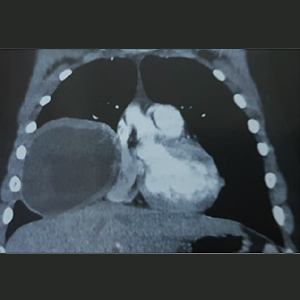Giant pulmonary hydatid cyst in children

All claims expressed in this article are solely those of the authors and do not necessarily represent those of their affiliated organizations, or those of the publisher, the editors and the reviewers. Any product that may be evaluated in this article or claim that may be made by its manufacturer is not guaranteed or endorsed by the publisher.
Authors
Hydatid disease is still endemic in Tunisia. It is mostly seen in young people less than 40 years and children are affected in one third of cases. The lungs are the predominant location in children. Our study aims to define the particularities of children PHC's (pulmonary hydatic cyst) management, the characteristics of giant cyst and to study predictive factors of complications. We included retrospectively 105 children with PHC followed between 1999 and 2019. Patients were aged less than 16 years with surgically confirmed diagnosis of PHC. Two groups of cysts were defined: giant cysts which were 10 cm across or more, and no giant cysts.The sex-ratio was 1.38 with a mean age of 10.5±3 years. The symptomatology was dominated by cough (59%), thoracic pain (51%) and hemoptysis (46%). Giant cysts were observed in 24 (22.9%) patients. Dyspnea (29% vs 5% p<0.001) and thoracic pain (88% vs 41% p<0.001) were significantly more frequently reported in giant cysts. Eighty-six patients had a single cyst (83%) and 19 had multiple cysts (17%). Giant cysts accounted for 22,9% (24 cases). Thoracic ultrasonography was diagnostic in 77.4%. The thoracic CT scan was performed in 27 children with inaccessible cysts in thoracic ultrasonography or in diagnostic doubt.Patients were all treated surgically. Surgical procedures consisted of cystectomy (59%), pericystectomy (18%) and pulmonary resection when parenchyma was destroyed (23%). Parenchymal resection was more often performed in complicated cysts (27% vs 20% p>0.05) and in giant cysts (41% vs 18% p<0.05). A two-stage thoracotomy was performed in the 4 patients with bilateral cysts. Thirteen patients presented immediate post-operative complications which occurred more frequently in complicated and giant cysts. Hospital stay was longer in complicated cysts (16±9 days vs 7±3 days; p<0.001) and in giant cysts (14±9 days vs 11±8 days; p>0.05). In endemic regions, the diagnosis of PHC in children should be based on the combination of thoracic radiography and ultrasonography which are effective, not costly, safe and accessible. Complicated and giant PHC cause lung damage leading to extensive parenchymal resection. They are more associated with post-operative complications prolonging hospital stay and increasing expenses.
How to Cite

This work is licensed under a Creative Commons Attribution-NonCommercial 4.0 International License.






